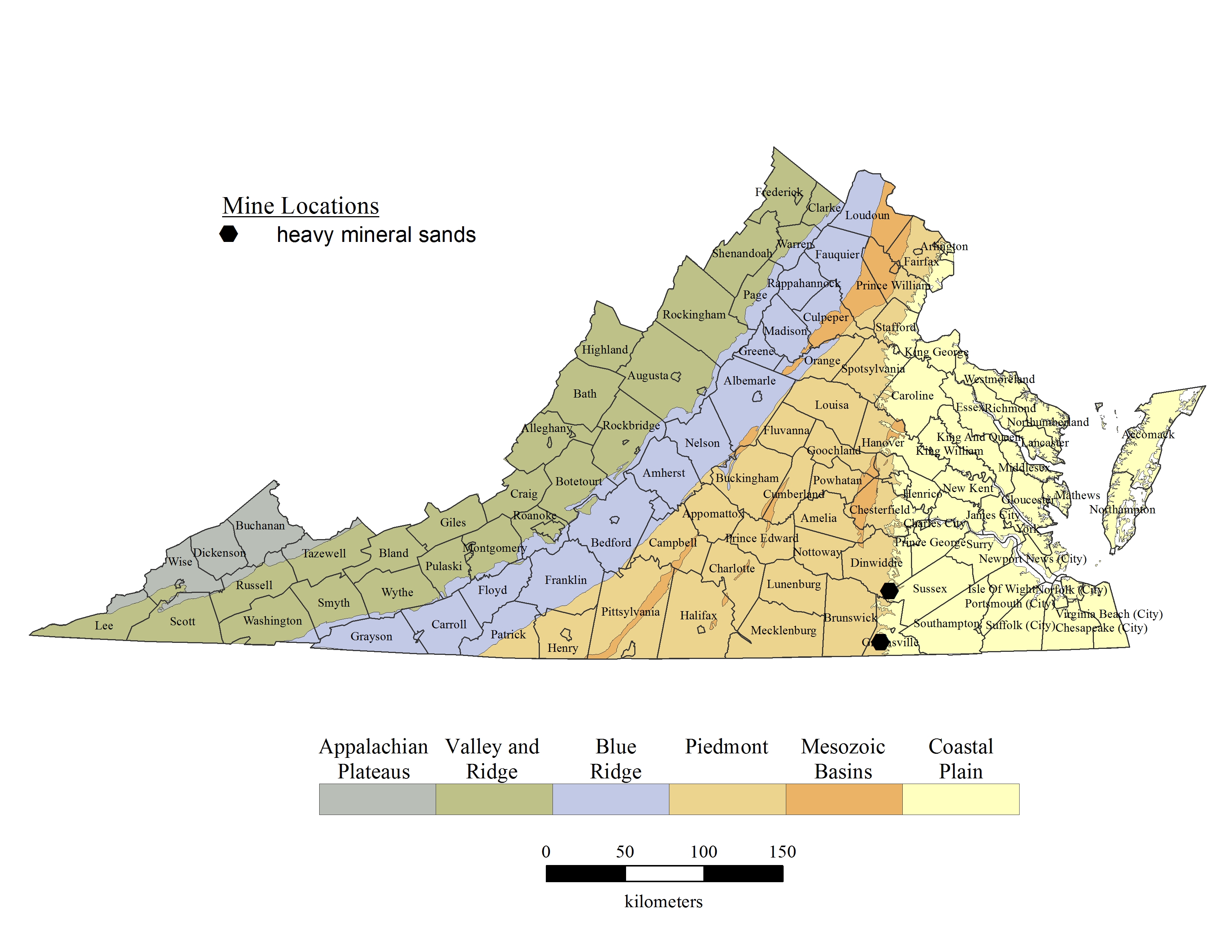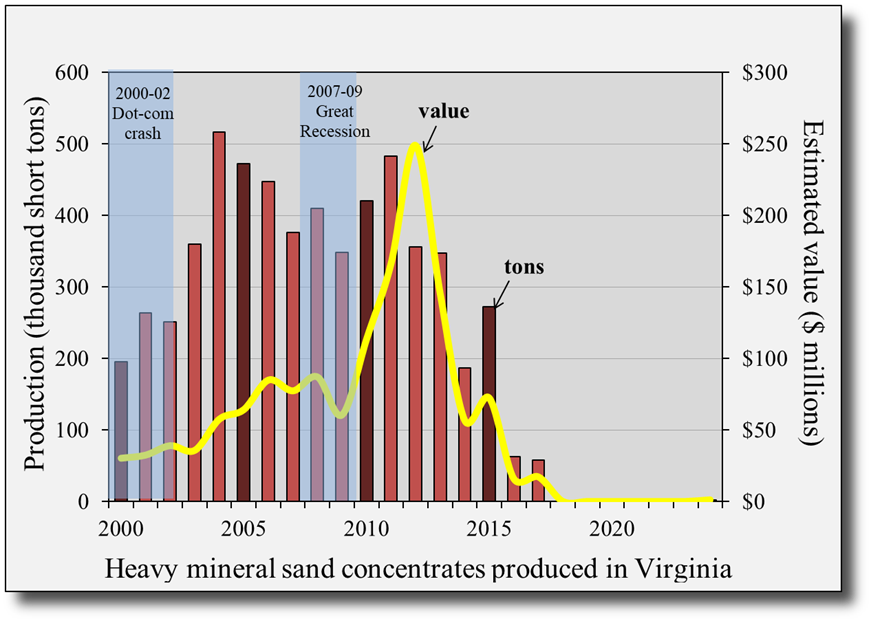Sedimentary deposits of sand, silt and clay often contain a small percentage of heavy mineral grains that have a higher specific gravity (greater than 2.9) than the more common quartz sand grains (about 2.65). Some are easily visible as dark and opaque grains, but others are light-colored or translucent and not as easy to distinguish from quartz. Heavy minerals include magnetite, ilmenite, leucoxene, rutile, zircon, garnet, monazite, among others. Some of these are valuable industrial minerals containing titanium, zirconium, alumina, and rare earth elements. Derived from the weathering of igneous and metamorphic rocks exposed in inland regions, heavy minerals can be concentrated by coastal, alluvial, and eolian processes that carry away the less dense grains, leaving behind the denser heavy mineral sands.
Year of first production in Virginia: 1997
County locations with commercial mining (past and present): Dinwiddie, Greensville, Sussex
Quantity produced in 2024: 1,950 tons
Estimated value of produced minerals in 2024: $1.2 million

Ilmenite (FeTiO3), leucoxene (altered ilmenite), and rutile (TiO2) contain titanium dioxide which is primarily used for the manufacture of white pigment used in paint, plastic, and paper. Rutile is also a source of titanium sponge metal used in steel alloy for applications in the aerospace industry, artificial joints and limbs, and heart pacemakers. Zircon (ZrSiO4) is a source of the element zirconium used in a variety of industrial chemical applications, as a ceramic glaze, and in refractory bricks and foundry sand in steel manufacture. Monazite (CePO4) typically contains natural admixtures of rare earth elements including cerium (Ce), lanthanum (La), neodymium (Nd), praseodymium (Pr), among others. These elements are used in energy generation, the manufacture of electronics, batteries and magnets, and a wide variety of other metallurgical applications. All of the minerals and contained elements listed above are among the 50 commodities listed in the USGS's 2022 Critical Minerals list.
Economic deposits of heavy minerals may be found in modern sediment accumulations as well as in ancient beach deposits that may be far inland from today's shorelines. In Virginia, Iluka Resources Ltd produced titanium and zirconium concentrates at the Old Hickory and Concord deposits in Dinwiddie County, and at the Brink operation in Greensville County. These heavy mineral deposits formed in beach and dune sands about 3 to 4 million years ago during the Pliocene Epoch, when the Atlantic Ocean shoreline was at a higher elevation near the present location of Richmond.
Ilmenite, leucoxene, rutile, and zircon make up approximately 80 percent of the heavy mineral concentrates produced by Iluka. The mined sediments were processed through gravity spiral concentrators to separate the denser heavy minerals from the lighter density non-economic mineral grains. Electrostatic and magnetic separation further concentrated the individual heavy mineral constituents. In 2017, Iluka suspended operations, but continues to hold mining leases in these areas.
As of 2024, Atlantic Strategic Minerals have restarted mining operations at their Millrun Mine near Stony Creek, VA (https://www.atlanticstrategicminerals.com/). Additional investigations regarding heavy mineral sands have been completed as part of the Earth MRI program.

Annual production and estimated value1
1 Estimates of annual mineral value are calculated using tonnages reported to Virginia Energy and commodity sales prices reported in numerous published and unpublished sources. The prices may include national or global industry averages. The calculated annual values do not necessarily reflect the actual sales prices received by mine operators in Virginia.
Selected References:
Berquist, C.R., 2010, Heavy mineral analyses of four samples, Virginia Coastal Plain (October 2010): Virginia Division of Geology and Mineral Resources, data available upon request.
Berquist, C.R., 1987, Minerals in high-level gravel deposits along the fall zone of Virginia: Virginia Division of Mineral Resources, Virginia Minerals Vol 33, No. 4, p. 37-40.
Berquist, C.R., Shah, A.K., and Karst, A., 2015, Placer deposits of the Atlantic Coastal Plain: stratigraphy, sedimentology, mineral resources, mining and reclamation: Cove Point, Maryland, Williamsburg and Stoney Creek, Virginia: Society of Economic Geologists, Guidebook Vol 50, 48 p.
Carpenter, R.H., and Carpenter, S.F., 1991, Heavy mineral deposits in the upper Coastal Plain of North Carolina and Virginia: Economic Geology, Vol 86, p. 1657-1671.
Hawkins, D.W. and Lassetter, W.L., 2022, Geologic map compilation and geochemical investigations in the Earth MRI Virginia Fall Zone placer focus area: Virginia Department of Energy, Geology and Mineral Resources Program Open-file Report 2022-01, 50 p. and Appendices.
Newton, M. C., III, and Romeo, A.J., 2006, Geology of the Old Hickory heavy mineral sand deposit, Dinwiddie and Sussex counties, Virginia: in, Reid, J. C., (ed.), Proceedings of the 42nd Forum on the Geology of Industrial Minerals: North Carolina Geological Survey Information Circular 34, p. 464-481.
U.S. Geological Survey, 2024, Titanium Statistics and Information
U.S. Geological Survey, 2024, Zirconium and Hafnium Statistics and Information
